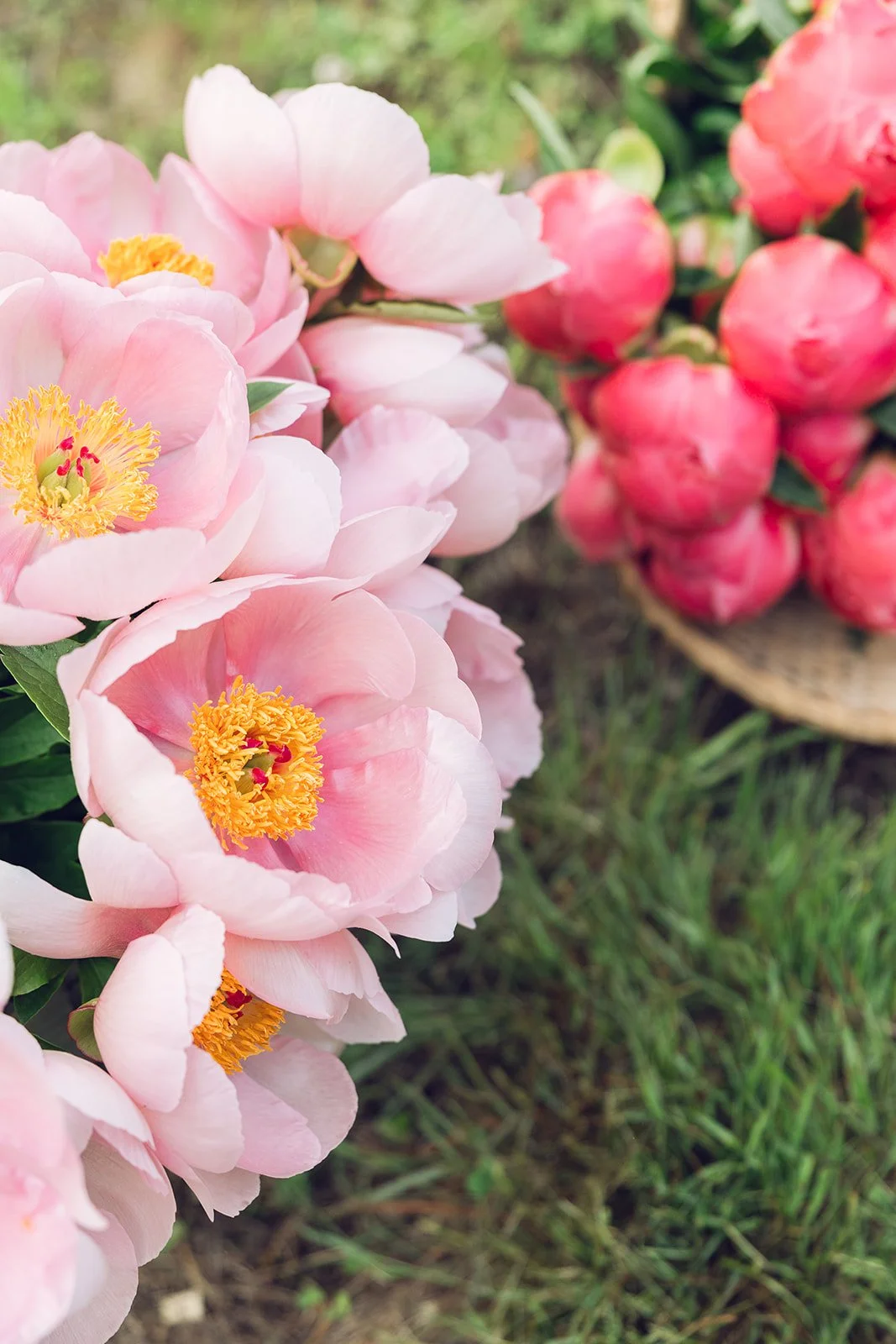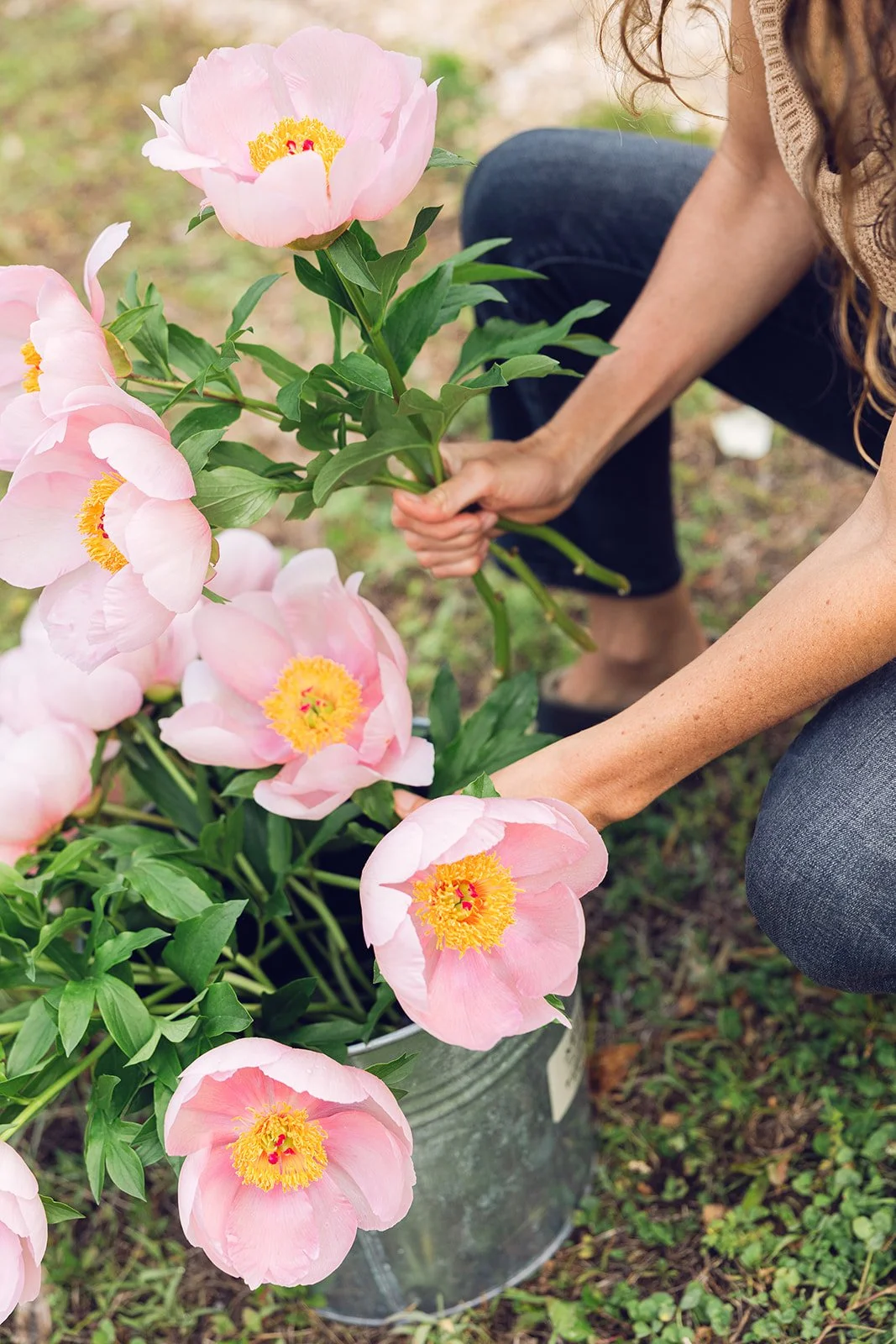If you’re considering growing peonies for cut flowers, understanding your potential yield is essential for planning both your harvest and your profits. At Tanglebloom, we use practical experience and data to guide our planning—and you can too.
Read moreAre Peonies a Profitable Crop for Small Flower Farms?
If you’re considering adding peonies to your small flower farm, you probably want to know one thing first: are they worth it financially? From my experience at Tanglebloom Farm, the answer is a resounding yes—if you plan strategically.
Read moreHerbaceous, Tree, and Itoh Peonies: What’s the Difference?
If you’re a flower farmer or small-scale grower, knowing the types of peonies is essential for planning your farm, maximizing blooms, and managing care. Peonies come in three main types: herbaceous, tree, and Itoh (intersectional). Each has unique characteristics, and understanding them helps you choose the right varieties for your climate, garden, or cut flower business.
Read moreHow Much Space Should I Leave Between Peony Plants for Cut Flower Production?
If you’re planning a peony field for cut flowers, one of the most important decisions you’ll make is how far apart to plant your peonies. The right spacing sets your farm up for long-term success, better blooms, and easier harvesting.
From my experience at Tanglebloom Farm, generous spacing is always worth it. Peonies are perennials that can remain productive for 50+ years, so planning ahead will save you headaches later.
Read moreWhat type of soil do peonies need to thrive?
Peonies are beloved for their lush, fragrant blooms and incredible longevity—but they can also be a bit picky about where they’re planted. The secret to happy, healthy peonies starts underground, with the right soil conditions.
Here’s what you need to know to give your peonies the best possible start:
Read moreHow Many Years Does It Take for Peonies to Bloom After Planting?
If you’re planting peonies for the first time, one of the most common questions is: How long until peonies bloom?
The short answer: bare root peonies usually begin producing abundant flowers in their third year.
But what happens in years one and two makes all the difference for the health and productivity of your plants. Let’s look at the timeline more closely.
Read morePeony Farming: A Beginner’s Guide to Building a Profitable Crop
Photo Krystina Olsen Studio
So, you’re curious about peony farming—and wondering if it’s right for you. Whether you’re a new flower farmer, a homesteader, or a florist dreaming of your own patch of blooms, peonies can be a rewarding (and profitable) crop.
In this beginner-friendly guide, I’ll walk you through the basics of starting a peony farm—and how to do it in a way that sets you up for profit.
Read moreProfitable Peonies: How to Choose Varieties That Sell
Photo Krystina Olsen Studio
You may have heard that peonies are among the most profitable flowers you can grow—but here’s the truth: not all peonies are equally profitable.
Some varieties are reliable workhorses, while others are showstoppers with limited demand. Choosing wisely can mean the difference between steady sales and wasted field space.
In this article, we’ll cover how to choose profitable peony varieties for your flower farm or floral business.
Read moreIs Peony Farming Profitable? The Real Numbers Behind a Legacy Crop
If you’ve ever wondered, “Is peony farming profitable?” you’re not alone. This is one of the most common questions I hear from new and aspiring flower farmers. The short answer? Yes—but only if you understand how peonies fit into your farm’s business model.
In this guide, we’ll break down the startup costs, potential revenue, and what makes peonies one of the most reliable, profitable cut flowers you can grow.
Read moreGrowing Peonies for Profit: A Quick-Start Guide for Flower Farmers and Florists
Discover how to grow, harvest, and sell peonies for profit. This beginner-friendly guide is packed with tips for launching a profitable flower farm using this low-maintenance, high-value crop.
Read moreThe Ultimate Guide to Growing and Harvesting Peonies
It’s almost peony season, and I often receive questions from gardeners about growing these stunning flowers, so today, I’m answering the top ones. Read on for essential peony growing and harvesting tips!
Read morePreserving Pussy Willows for Year-Round Use
In a cold climate, the first harvest of the year isn’t actually flowers, but…sticks.
(Thanks to Noah Kahan you know what “stick season” is, right?)
Usually in February we harvest the first pussy willows (Salix spp.) for Valentine’s Day sales, or to mix with winter-grown tulips. Thanks to cold winter temperatures, and by growing a few different varieties, we can extend the harvest season through March.
When to harvest Pussy Willows
Pussy willows (Salix spp.) are best harvested just before the catkins are fully exposed. A good stage is when the papery covering starts to easily fall off as you touch the branches. If the catkins are starting to show pollen, they’re too developed for fresh cut use or preserving (but pollinators will appreciate them!).
Can you dry pussy willows?
Since they “bloom” so early, often before flower farmers have a lot of other fresh product, people often wonder if you can dry them for later use.
While you can do the hang-to-dry method used for most everlasting cut flowers, I’ve found it often results in stiff, brittle stems that are hard to transport and design with, as the catkins tend to shed easily when touched.
You know I’m all about keeping things as simple as possible so we can run a sustainable, profitable business. This is one instance where it’s worth taking an extra step in the preservation process.
The result?
Beautiful pussy willow stems that remain pliable for use in floral design, displaying without water, or mixing into dried flower bouquets. By preserving your soft fuzzy willow branches, you can now sell and design with them all year round!
How to Preserve Pussy Willows with Vegetable Glycerin
You’ll need to take a quick trip to your local drugstore or cosmetic supply store (or even grocery store, pharmacy, or herbal product shop) to pick up a bottle of vegetable glycerin. Otherwise, you probably already have everything else you need.
Supplies:
• freshly cut pussy willow stems
• vegetable glycerin
• heatproof measuring cup or glass jar
• spoon
• boiling water
• sturdy vase or bucket
Method:
Pour one part glycerin to a heatproof measuring cup or glass jar (I use a Mason jar with the ounces marked on the side for easy measuring).
Add two parts boiling water (let it cool 1-2 minutes before pouring) to the glycerin, and stir to combine.
Pour the glycerin mixture into a sturdy vase or bucket that will accommodate your willow stems, while allowing the liquid to come up the stems several inches.
Add willow branches to your container with the glycerin mixture.
Allow the stems to “soak up” the glycerin mixture for 2-3 weeks. Stems will darken as they soak, and remain pliable.
After the preservation process is complete, you can remove the stems from the glycerin and gently wipe with a towel.
Carefully store them upright in a dry vase or bucket away from sunlight, or wrap in tissue or kraft paper and store in boxes or bins.
Stems can now be displayed without water, mixed into dried flower bouquets, or used in floral design work.
Preserved pussy willow branches can last 1-2 years if properly stored!
Favorite varieties to grow:
• 'Purple Heirloom' has thin blonde wood and purple-grey catkins
• Japanese Pink 'Mount Aso' features pretty pink catkins
• Giant "Discolor' familiar variety with very large catkins
• Black 'Melanostachys' has dramatic black catkins
Sources for pussy willow cuttings:
Ampersand Bulb Co., The Painted Tulip, Sunny Meadows Flower Farm, FedCo Seeds, White Flower Farm, Morey Hill Farm, Cold Stream Farm
How to Grow Hellebores
Viburnum for Cutting & Arranging
Viburnum nudum ‘Winterthur’ is an easy-to-grow native producing striking dark blue berries on red stems with glossy green foliage that turns a glossy burgundy in September and October.
Read moreHow to Divide Northern Sea Oats, a Perennial Grass for Cut Flowers
Northern Sea Oats (Chasmanthium latifolium) is a perennial grass with beautiful seedheads useful in both fresh and dried floral arrangements. This lovely ornamental grass is also native to the eastern United States, and makes a great plant for naturalizing landscapes.
Read moreGrowing Peonies with TANGLEBLOOM: The Backyard Bouquet Podcast
In This Episode You’ll Hear About:
Melissa’s journey to flower farming (00:02:30)
Starting a flower CSA (00:07:18)
Transition to agritourism and education (00:14:30)
Focus on peonies and perennials (00:17:23)
Agritourism and Glamping (00:22:48)
Niche Down to Peonies (00:26:11)
Lessons Learned and Challenges (00:33:00)
Peony Growing Tips (00:36:56)
Favorite Peony Varieties (00:42:57)
Controlling botrytis and other diseases (00:49:08)
Harvesting peonies and preventing thrips (00:57:52)
Relocating and dividing peonies (01:02:25)
Harvesting peonies in the first season (01:03:38)
Harvesting and Marketing Strategy (01:04:49)
Peony Course (01:07:44)
The Backyard Bouquet Podcast | Episode 25
Perennial Campanula for Cutting and Arranging
This perennial campanula is a cottage garden classic that looks like it belongs in a fairytale, and is virtually pest and disease free.
Read moreHow to Divide Geum Plants for Cut Flowers
Geum are a compact perennial producing semi-double blooms in early summer. Cut flower stem length ranges from 15-18” making Geum a wonderful accent for floral arrangements. Hardy in zones 5-9, they need to be divided every 2-3 years to remain vigorous. Here’s how to divide your Geum plants quickly and easily.
Read moreWhat I Wish I Knew Before Starting a Flower Farm
While it's unrealistic to expect you won't make any mistakes, I hope you'll learn something valuable that saves you time, stress, and money.
Read moreFavorite Spring Perennials for Cut Flowers - and Foliage
As we say farewell to winter’s chill and embrace the vibrancy of spring, I’m highlighting three perennial plants that not only make excellent fresh cut flowers, but also wonderful foliage for floral design: Forsythia, Baptisia, and Spirea.
Forsythia: Sunshine on a Stem
Gah, Forsythia – that unapologetic harbinger of spring with its showers of golden blooms. This early blooming shrub is a must-have for any flower farmer-florist.
👩🏽🌾 Growing Forsythia is a breeze – they thrive in US Hardiness Zones 5-9 in well-drained soil and full sun, though they can tolerate some shade. Plant them in the fall or early spring for a burst of color when the days start to lengthen. Give them plenty of room to spread out and you’ll be rewarded with prolific fresh cuts for decades!
✂️ Clip stems when the buds are just beginning to show color but haven't fully opened yet. Forsythia is also a great choice for forcing: pick stems a little earlier, before buds are showing color, and watch the magic unfold as the flowers bloom indoors within 4 to 5 days.
🌿 Long after the blooms have dropped, forsythia can be cut for its foliage to use in floral arrangements. It even holds up well out of water! Come autumn, the foliage turns a lovely shade of reddish-purple, perfect for fall wedding floral design.
🏺 Forsythia has a 7-day vase life.
Baptisia: Double Duty Beauty
If you're in the market for a perennial that's as stunning in foliage as it is in flowers, take a look at Baptisia. Also known as false indigo, this plant boasts spikes of pea-like blooms in shades of blue, purple, pink, and white; complemented by blue-green foliage. Baptisia is darn tough, thriving in poor soil and drought conditions once established.
👩🏽🌾 Baptisia is a bit of a slow-grower, hardy in Zones 3-9. Look for liners from your perennial wholesaler if you have a while to wait and want to establish a sizeable patch. Otherwise, grab some quart or gallon pots from your local nursery, or search online to source newer specialty colors. Once established, they require minimal maintenance, making them a favorite among busy flower farmers.
✂️ Harvest Baptisia stems when about a third of the flowers on the spike have opened for the longest vase life.
🌿 For foliage, cut anytime after flowers have faded, cutting low in the plant to reach woody stem.
🏺 With proper care, these beauties can last up to 10 days in a vase.
Spirea: Spring Elegance
Spirea – the epitome of spring elegance with its delicate clusters of blossoms adorning arching branches. This versatile shrub comes in a variety of cultivars, offering a range of flower colors from white to pink to deep rosy hues. Spirea is a breeze to grow, thriving in a wide range of soil conditions and tolerating both sun and partial shade.
Pro tip: Many garden centers now sell compact varieties. Look for the O.G. Vanhoutte Spirea AKA bridalwealth for high production to give you lots of fresh cuts. We find white to be the most versatile for event work.
👩🏽🌾 To grow Spirea in Zones 3-9, plant in the fall or early spring in well-drained soil enriched with organic matter. Prune them after flowering to encourage bushiness and prolific blooms the following year.
✂️ When harvesting Spirea for floral arrangements, select stems with half-opened blooms for the longest vase life.
🌿 For foliage, harvest anytime after flowers have dropped and let their graceful, arching stems shine in arrangements and wedding bouquets.
🏺 Spirea can last 7-10 in a vase with proper care.
Fast Favorites for a Reason
Forsythia, Baptisia, and Spirea are three of my favorite spring blooming perennials that every flower grower and floral designer should have, for both their beautiful blooms and versatile foliage.
These prolific performers are easy to grow and low maintenance, making them a great choice for both beginners and busy flower farmers alike.
Do you have a favorite way to grow or use these springtime perennial cut flowers? Let me know below in the comments.










